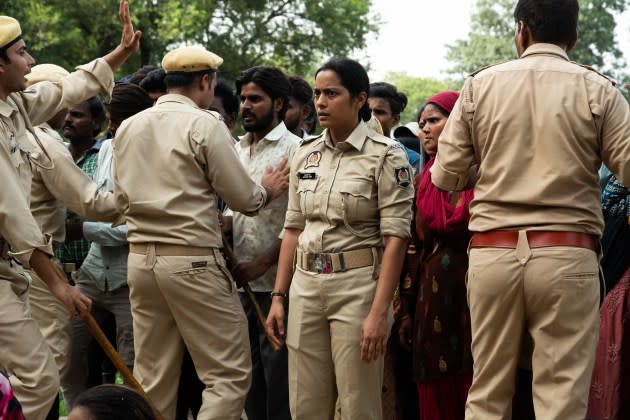‘Santosh’ Review: A Dramatic Inquiry Into Images of Indian Policing

While often more intellectually stimulating than emotionally engaging, “Santosh” lays bare the dark heart of communal divisions in modern India. Sandhya Suri’s narrative debut follows a driven young Hindu widow who inherits her husband’s job as police constable thanks to a government scheme. While the movie speaks the language of a fiercely feminist empowerment saga, it also zeroes in on what power actually means in a highly stratified society when a murky crime leads to the incendiary unfurling of dimensions of religion and caste.
“Santosh” is tethered to the perspective of its titular character. Actor Shahana Goswami embodies Santosh’s grief with striking resilience as she navigates a labyrinth of institutionalized misogyny and post-mortem red tape, but the movie is quick to put her in the khaki uniform of the Indian police. She’s rarely seen without it, and becomes a cinematic symbol in the process. “Santosh” may be an independent Hindi production set in a small town, but it feels distinctly in conversation with its bombastic Bollywood cousins, which have recently taken a concerning bent in the way they revere India’s Hindu nationalist status quo and the abuse of police and political power. Take the ongoing “Cop Universe” by director Rohit Shetty, a series of interconnected, star-driven action films celebrating vigilante police officers. Shetty’s 2018 movie “Simmba” concluded with an unsettling appeal from uniformed authority figures for suspected rapists to be killed extra-judicially.
More from Variety
“Santosh” effectively deconstructs this police power fantasy, from its overlap with modern notions of gender equality, to its adherence to the rigid social strata of modern India’s Hindu and upper-caste hegemony. Santosh’s uniform may grant her status and prestige on par with her male co-workers, but the implications of that status include the moral policing of young couples, and the public humiliation of poor suspects — not to mention, private torture to elicit confessions (another recurring image in mainstream Hindi cinema). Watching Santosh learn the ropes of her local police station is amusing at first, but Goswami sells its increasing complications through silent reaction shots as her character becomes slowly absorbed by this power structure, its in-group language, its secrets and its casual corruption.
When the murder of a “lower caste” Dalit girl yanks her precinct into a media firestorm — first, for their indifference to Dalit plight and then for the indignity foisted upon the deceased and her family — a seasoned, charismatic policewoman, Inspector Geeta Sharma (Sunita Rajwar) is called in to lead the case. She becomes a mentor to Santosh, and despite what appear to be ulterior motives, she ushers the young widow toward a form of self-actualization that, while cathartic for Santosh herself, has unsavory ripple effects for the case.
Santosh’s self-assured demeanor as an upper caste, middle class Indian woman takes the form of aggression and trickle-down entitlement when she speaks to those farther down the social ladder: people of oppressed castes and eventually Muslim characters, as she begins to pursue a Muslim suspect. The movie’s text echoes the self-righteousness of many modern Indian crime stories, in which police power is considered a virtue. But the subtext beneath that fa?ade, exposed through subtle modulations in Goswami’s and Rajwar’s performances, captures the shifting and conditional nature of Indian justice in chilling ways. It transforms, as its police characters do, depending on the caste, religion and social status of who else is on screen.
While the films lacks ambiguity about the case — and thus, lacks the dramatic power of gradual reveals and realizations — it remains firm in its commitment to capturing the ugly allure of power through the perspective of those who wield it. Clues about how Santosh’s husband may have died (during a communal riot in a Muslim neighborhood) don’t quite spell out the thornier aspects of her grief or the reasons she’s so driven to solve the central murder, but they force a more critical reading of her motives.
Suri’s camera seldom leaves Santosh’s side, always following her as she moves through space toward some inevitable release of fury, or sitting with her during intimate moments of introspection. It seldom probes beyond the surface of her reactions, which can make “Santosh” an occasionally distancing experience. But in the process, it finds value as an academic inquiry into familiar moving images by forcing the audience to lean forward and inspect their meaning and infer for themselves the most unsavory implications of the caste structures and Islamophobic norms so often taken for granted in the mainstream Indian milieu.
Best of Variety
Sign up for Variety’s Newsletter. For the latest news, follow us on Facebook, Twitter, and Instagram.